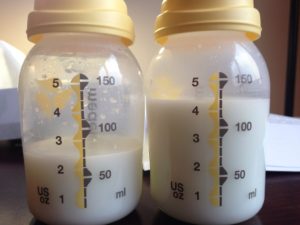One of the biggest stressors for a new mom preparing to return to employment is the baby who WILL NOT take the bottle.
In my experience, there are two types of “bottle refusal” – Passive Refusers, and Active Refusers. A “Passive Bottle Refuser” will allow the bottle nipple into his mouth but then doesn’t really seem to know what to do with it – he may just chew or play around with it, rather than latch and transfer milk, and eventually will get frustrated, hungry or bored, and begin to fuss. The “Active Bottle Refuser” doesn’t want the bottle nipple in (or sometimes, even near!) his mouth, and will resist or protest attempts to feed him with the bottle: he may cry (or scream), arch, fight or pull away as the bottle nipple approaches or enters the mouth.
The Passive Refuser seems like he doesn’t know what he’s supposed to do with the bottle. The Active Refuser is angry and upset about the whole scenario!
If you have an Active Refuser, the first step is to reduce the stress and negative associations already established around bottle-feeding attempts. Avoid reinforcing negative associations with the bottle/nipple. If your baby is crying and fighting and trying to push the nipple out of his mouth, don’t keep pushing it back into his awareness: take a break or stop for that session. Forcing it on the baby, or making him gag and cry with the nipple in his mouth will not magically result into drinking from the bottle. It just reinforces the negative experience and makes the baby anxious the next time the bottle presented.
Here are a variety of suggestions that can be successful. Some may seem non-traditional, but when the usual suggestions aren’t working, sometimes you need to think out of the box.
Timing: Consider Morning, Not Evening
If the non-nursing partner is offering the bottle, try mornings rather than evenings. In general, everyone’s stress level is lower in the morning, and most babies are happier in the morning and grumpier in the evening. If the bottle isn’t going well, working on it during an already stressful time of day won’t help.
Positioning
Try some non-traditional feeding positions if the usual “sit, cuddle, feed” position isn’t working for you.
Up and Out: Hold baby in a sitting position, facing out against your chest, as you walk around the room, or better yet, walk around outside. Movement and distraction can be very helpful.
Bounce: Sit on a physioball (gym-, yoga-, birth ball) and bounce while offering bottle. Try both a cradled position and a facing out position.
Wear the Baby: Does baby like his carrier? Wear baby in the ERGObaby, Moby Wrap or BabyBjorn, walk around indoors or out, while offering bottle.
The “Disembodied Arm” Technique: Just what it sounds like! Have baby in a car seat or bouncer seat facing something distracting (television?). Sit behind baby, out of sight, with bottle coming around from behind.
Don’t worry that you’ll need to feed your baby using these unusual methods in the long term, we’re taking it step by step. The first step is to encourage baby to allow the bottle nipple into his mouth, latch and transfer milk effectively. Once this is happening reliably, you can work on transitioning that skill to occur in different settings and positions, such as sitting in a rocking chair.
Bottle nipples
Try a few, not dozens: If you’ve had any success with a particular bottle nipple, stick with that one. It’s generally not an issue of trying 20 different bottles/nipples until you find the magic one that baby will accept. It does make sense to try a few but then try working with the one you think baby did the best with.
Nipple flow rate: The flow rate can be another helpful factor. I usually recommend a slow-flow bottle nipple for most breastfed babies, but if you know that your baby gets a lot of milk at the breast in a short amount of time (for example, if you have a heavy milk letdown), then you might want to try the next flow rate up (size 1-2 or 3+ month size). Just make sure to hold her upright and keep the bottle almost horizontal, so she doesn’t feel flooded out with too much milk if she does start sucking.
Latex or Silicone? Bottle nipples are usually available in two different materials. Even with the same shaped bottle nipple, a latex (tan-colored) nipple will feel softer and squishier than a clear, firm silicone nipple. It’s worth trying both latex and silicone to see if your baby has a preference regarding texture and firmness.
Read more on Selecting a Bottle Nipple.
Tease-Remove Technique
Have you seen your baby, sound asleep still attached at the breast, barely flutter-suckling, body relaxed, arms limp? Yet, the moment you try to break the latch and take baby off the breast, he’ll start sucking frantically, like saying “wait – wait – no – don’t take that away, I wasn’t done!” Try eliciting that response with the bottle nipple: when you feel baby tentatively latching on the nipple, gentle traction back as though you’re teasing to take the nipple away. Some babies will respond by sucking harder to draw the nipple back in and keep it there. If this happens, try using some movement and distraction (quick!) and see if baby will continue sucking and get into a suck-swallow-breathe pattern. Remember to always aim the tip of the bottle nipple toward the roof of the baby’s mouth.
Milk for the Discerning Palate
Some babies are very particular about what’s in the bottle. Try using freshly expressed milk, if your baby has been refusing frozen. And, though I’m not usually particular about the temperature of the milk offered (most babies don’t mind lukewarm or even cool milk), if you have a bottle-refusing baby, try making the milk quite warm. For some reason, very warm milk seems to work better for many babies who are reluctant about the bottle. If your baby is over four months old, you could consider trying one ounce of white grape juice and one ounce of water. Some babies will initially refuse milk, but readily take juice from the bottle. Though the recommendation is exclusive breastmilk close to six months, other pediatricians (and certain groups within the AAP) do suggest solid foods (cereals, fruits and vegetables) any time after four months. Again, this is an untraditional approach (and I’m not one to encourage juice intake, especially from a bottle!), but one that may help bridge the ability to bottle feed an older baby.
Recruit a Confident and Experienced Feeder
Have a very experienced bottle-feeder offer the bottle. A professional caregiver who feeds many babies regularly or a friend or fellow new-moms-group attendee who bottle feeds her own baby may have body language, tricks and methods that you or your partner haven’t yet tried. Make sure s/he knows NOT to force the bottle, and that it’s perfectly alright if it doesn’t end up happening that day. You don’t want her to push too hard in her attempts to be successful and save the day! Experiment with sitting right in front of your baby so she can see you, or leaving the room or having the caregiver walk around in another room while offering the bottle.
Don’t Try a Holding out Game
Do not attempt to withhold the breast for an extended period in order to force the baby to take the bottle out of hunger. It is unkind, unnecessary, and usually unsuccessful, especially if baby has not been able to successfully transfer milk from the bottle before. Slow, consistent, unstressed encouragement tends to yield the best longer-term success.
Which brings us to perhaps the most effective and successful technique: Intermittent Bottle By Mom (IBBM)
Intermittent Bottle by Mom
One less-traditional, but highly successful technique I find works well is to have mom work on the bottle feeding since you are the person your baby most associates with feeding, and you are both comfortable and relaxed together. Also, you have the “luxury” (ha!) of time in the morning to work together over several subsequent feeds, whereas your partner is usually trying to work on bottle feeding in the evening during the hardest time of the day, when no one has much energy or patience left.
During an early morning feeding, begin nursing at the breast as usual, and then interrupt the breastfeeding and offer the bottle. If she doesn’t accept the bottle, don’t force it, just put her right back on the breast for another minute or two, and then try once again with the bottle. Go back and forth between the breast and bottle without forcing it at her. Try to have the attitude of “you can get milk here (breast), you can get milk here (bottle), it’s all milk, it’s all good, either is fine!”. Pretend like you don’t mind if she refuses the bottle, just put her back on the breast. If she ends up not taking any of the milk at that early morning feeding, you can leave it on the counter (or refrigerate and rewarm) and try again at the next feeding, 2 hours later before deciding to toss it – that’s why I suggest only using an ounce or two of milk in the bottle, so you won’t be wasting much if she refuses it altogether.
Try this Intermittent Bottle By Mom (IBBM) technique for several feedings during the day, for several days in a row. Remember, never let baby get distressed with this method: If she resists or refuses the bottle, allow her to go right back to the breast. Almost always, moms begin to see success by day 3 or 4, and by 7 – 10 days, baby is often readily taking an ounce or more from the bottle. Success!
 I’m back at work and my baby is 14 weeks old. I have been pumping twice during my workday (9 AM and 1 PM) and I can pump about 10 to 12 ounces a day with these sessions.
I’m back at work and my baby is 14 weeks old. I have been pumping twice during my workday (9 AM and 1 PM) and I can pump about 10 to 12 ounces a day with these sessions.
